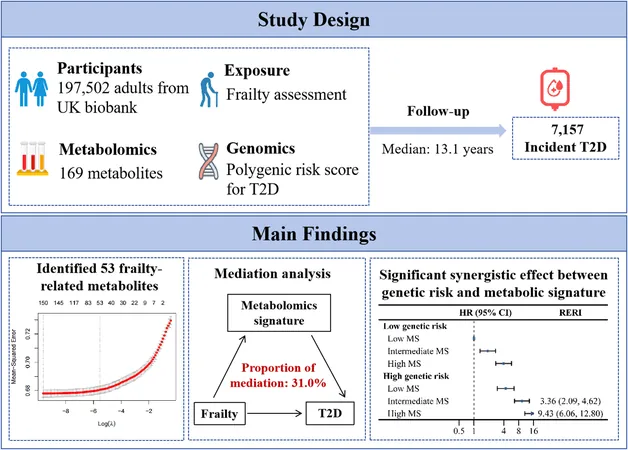
Unlocking the Link: How Metabolic Changes and Genetics Influence Frailty and Type 2 Diabetes
2025-05-24
Author: Wei Ling
The Backbone of a Groundbreaking Study
The UK Biobank study, a monumental research project, engaged over 500,000 participants aged 37 to 73 from various locations across the UK. This comprehensive study collected extensive data from physical examinations, questionnaires, and biological samples to crack the code on health outcomes.
Who Was Included?
Out of the initial pool, a meticulous selection process whittled down participants to 354,157 for frailty analyses, and later to 197,502 when focusing on metabolic data. By following strict guidelines (STROBE), the research meticulously ensured a solid framework for understanding these intricate relationships.
Decoding Frailty
Frailty was evaluated based on five critical indicators: weight loss, exhaustion, slow walking pace, low grip strength, and lack of physical activity. Participants who met three or more criteria were marked as frail, paving the way for a detailed scoring system that quantified the frailty's impact.
Follow-Up and Findings
During the study’s extensive follow-up (averaging 13 years), researchers discovered significant correlations between frailty and the onset of Type 2 diabetes (T2D). Participants classified as frail or pre-frail faced drastically higher risks of developing T2D, emphasizing the critical nature of early detection.
The Genetic Factor
Adding another layer of intrigue, the study evaluated genetic predisposition using a polygenic risk score (PRS). Those in the high-risk group exhibited an even more profound connection between frailty and T2D, illustrating how our genetic makeup can shape health risks.
Metabolic Signatures Unveiled
The team identified 53 significant metabolic biomarkers tied to frailty, revealing how various lipids and amino acids are crucial in predicting T2D risks. This metabolic signature provided a striking overview of how aging and health factors intertwine.
Revealing Mediators and Interactions
Intriguingly, nearly one-third of the association between frailty and T2D risk was mediated through metabolic changes. This underscores the potential of metabolic interventions to alter health trajectories. Moreover, the study unveiled interactions between genetic risk factors and metabolic signatures, marking a sophisticated interplay that could redefine preventive strategies.
Broadening Perspectives on Health
While this study shines a light on how frailty, genetics, and metabolism intertwine to affect T2D risk, it also calls for further research. Understanding these dynamics can pave the way for targeted interventions, ultimately reducing the global burden of diabetes and aging.
In Conclusion
The findings presented here are significant not only for individual health but also for public health strategies. Implementing lifestyle modifications and early interventions could be key in managing frailty and its metabolic consequences for healthier aging. The intersection of metabolomics and genetics is more than just biology—it's a holistic approach that may reshape the future of health management.


 Brasil (PT)
Brasil (PT)
 Canada (EN)
Canada (EN)
 Chile (ES)
Chile (ES)
 Česko (CS)
Česko (CS)
 대한민국 (KO)
대한민국 (KO)
 España (ES)
España (ES)
 France (FR)
France (FR)
 Hong Kong (EN)
Hong Kong (EN)
 Italia (IT)
Italia (IT)
 日本 (JA)
日本 (JA)
 Magyarország (HU)
Magyarország (HU)
 Norge (NO)
Norge (NO)
 Polska (PL)
Polska (PL)
 Schweiz (DE)
Schweiz (DE)
 Singapore (EN)
Singapore (EN)
 Sverige (SV)
Sverige (SV)
 Suomi (FI)
Suomi (FI)
 Türkiye (TR)
Türkiye (TR)
 الإمارات العربية المتحدة (AR)
الإمارات العربية المتحدة (AR)